|


| |
Birth of a Streamliner - Building Great Northern's 1947
Empire Builder
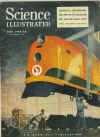
From the April 1947 issue of "Science Illustrated"
magazine
 
BIDDING FOR POSTWAR TRAVELERS, one of five Empire Builders glides along the Columbia River in Washington State. Train cuts 13 1/2 hours off the Chicago-Seattle run.
You will travel with greater speed, safety and luxury in this first fleet of postwar transcontinental trains.
So you're going to take a trip this summer!
It may well be the first time you've strayed from home grounds since the war, for vacation travel still wasn't easy last year. But the lid is off now, and if you go by rail, some pleasant surprises are in store for you.
Long hours of scientific research and experiments are back of the many new developments that are making railroad transportation safer, faster, and more comfortable today. The Great Northern Railway and the Burlington Lines have just put into service five new Empire Builders, the first transcontinental sleeping-car and coach trains to come from Pullman-Standard shops since the war. But these five 12-car trains, slashing 13 1/2 hours from the old schedules to make the run between Chicago, Saint Paul-Minneapolis and Seattle in 45 hours, represent patient planning that began even before the war.
Locomotives were ready
The 4,000 horsepower Diesel-electric giants that pull the new Builders over the mountains of the Northwest were completed two years ago by the General Motors Electro-Motive Division, and had been waiting patiently ever since for their strings of sleek new passenger cars. These locomotives, geared to 90-mile-per-hour speeds, have what it takes to make the long trains roll smoothly across the grades of the Rockies.

WELDING GIVES STRENGTH to body of Diesel-electric locomotive built for rugged travel on route of the Empire Builders.
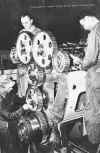
LOCOMOTIVE'S MIGHTY DIESEL GEARS AWAIT THEIR HOUSING
Comforts and conveniences of the Empire Builders, however, are only typical of the things the traveler may expect to find before long on trains all over the country. There are the seats in the Day-Nite coaches, for instance. Anthropologists measured and studied the sitting positions of nearly 4,000 persons to find specifications for a seat that would give the greatest comfort to the average person, and be readily adjustable to height, weight, and posture of almost everyone. Similar seats have been introduced in new coaches of the New York Central, Baltimore & Ohio, and Pennsylvania Railroads in the East.
Seats rotate so both occupants may watch the scenery with a minimum of eyestrain. They recline, too, and leg rests fold down from the seat ahead to provide chaise-lounge comfort for the recliner. Lights in the ceiling are arranged so as not to strike your eyes when you lie back to rest, and reading lights are controlled by the individual.

COACH SEATS ROTATE to give you a better view. They turn all the way, should four persons want to talk or play cards. A convenient ashtray for smokers is found on backs of some seats.
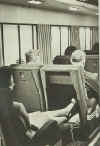
WHEN YOU'RE TIRED, you pull down footrest from back of seat ahead, and lean back in reclining coach seat. It's almost as good as a bed. The ceiling lights can't shine into your eyes.
Fog proof view of the rugged Northwest countryside is provided by double-paned windows, a vacuum between panes insulating the cars against outside temperatures. Windows are wide, and Venetian blinds can be adjusted to control glare from outside.
Progress has added a new member to the crew of each Empire Builder, a uniformed passenger representative who mans a public-address system for benefit of coach passengers. He points out spots of historic and scenic interest along the route, and makes other announcements of importance to the traveler via the loudspeaker. Radio and recorded programs also can be broadcast over the system.

DESIGNED FOR WOMEN, powder room of the Empire Builder coaches contains better lighting, huge mirrors, and wide shelves to hold an abundance of makeup paraphernalia.
Everything considered, these new coaches offer the ordinary traveler more for his money than many prewar Pullman cars were able to provide the de luxe passenger of yesterday.
In the de luxe cars of the Empire Builder, sleeping accommodations again reflect the result of much research into travel tastes that preceded the actual drawing of plans. For those desiring privacy, eight duplex roomettes, ingeniously staggered on two levels to give a double-deck effect, provide the lone traveler with his own room at little more than the cost of a lower berth. Beds of the duplex roomette, when lowered at night, are six feet, five inches long.
Some don't want privacy
In addition to the roomettes, each sleeper contains four bedrooms and four open sections with an upper and lower berth to each section. Although some railroaders have come to regard the conventional upper and lower as old-fashioned and outmoded, the Great Northern survey found quite a number of travelers who preferred them because of the sociability of the open section during the day. They, it seems, don't want to be alone.
All rooms have ice water on tap, eliminating the old-time water carafe. Wardrobes of bedrooms are placed alongside the aisle for greater convenience in hanging clothes. Toilet facilities are concealed, and the bedroom washstands can easily be converted into tables. Chairs and sofas add comfort to the rooms for daytime travel. Room temperature and lights are controlled by the individual.
Blackfoot motif
Eye appeal was not neglected in design of the Empire Builders, and artists sat down with the designers and engineers when the trains were planned. Drapes of diners echo the blues and greens of the lakes of Glacier National Park, and the tans and deeper hues of the Rockies. Colors of native flowers brighten car interiors, and a Blackfoot Indian motif runs throughout the train. Murals in observation-lounge cars reproduce Blackfoot portraits by Winold Reiss. Indian pictures by the late Charles M. Russell, Montana cowboy artist, drench the traveler in the atmosphere of the Northwest.
Smooth riding and safety are provided in new devices applied by the car builders. Electrically controlled brakes give maximum graduated braking at all speeds, and prevent wheel sliding. A red oscillating light at the rear of each train flashes a figure-eight warning, visible at great distances, when speed drops below a specified figure, or the train stops.
With a capacity of 307 passengers, each train has a mail-baggage car, 60-seat coach, three 48-seat coaches,
coffee-shop car, diner, four sleepers, and observation-lounge car. The five trains were built and furnished at a total cost of $7,000,000, including the locomotives. The latter's speed, incidentally, is part of a general trend to the level of 90 to 100 miles per hour. Increased pulling power gives faster schedules than higher speed.

COMFORT AND SPACIOUSNESS predominate in the design of lounge cars by Pullman-Standard, maker of the Empire Builder. Ample space is provided for stacking luggage. The movable easy chairs with footrests give passengers all the comforts of home.

SELF-SERVICE FOR DINING with an ample space at side tables is a feature of this cafeteria car. The basic design of the car is found in Empire Builder coffee shop.
Cars were first laid down in February 1946, after engineers and designers had agreed on basic structural and mechanical details. Radical differences in design called for new assembly methods, and the entire operation was placed on an assembly-line basis.
Cut to pattern
Patterns of wood, metal, or cardboard made from drawings guided shop workers in fabricating different parts. Special tools and dies had to be made without delaying the line. Backbones of the cars took shape in the steel shop, where center sill, end frames, and bolsters were welded into a strong unit that won't telescope.
As the underframes moved along the line, ends were attached, then the two sides, and the roof, forming a complete body-frame structure. This process is known as "laying down" the car.
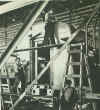
CAR END GOES INTO PLACE, the first piece to be set on underframe. It's bolted into position, then welded and riveted.
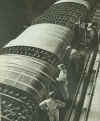
ROOF SHEETS ARE FITTED on roof jig, then welded tight by an automatic machine. When finished, roof gets a water test, and insulation and some air ducts are installed.
Cars were lined and leveled in a "car in shop" operation. Insulation and air-conditioning units were installed. Permanent trucks replaced temporary trucks, ending the "preparation of car" stage. In final phases, six different systems of car piping and two to five miles of electric wiring went into each car, and final paint and polish were applied.
The End
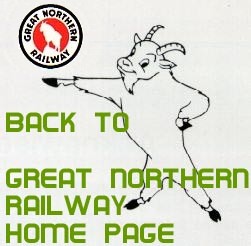 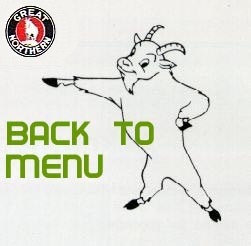 |